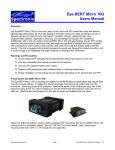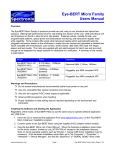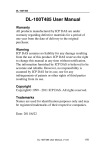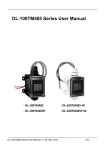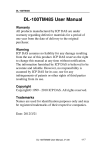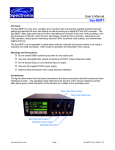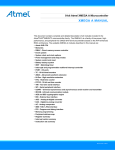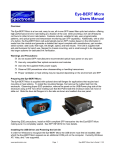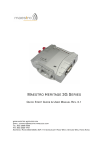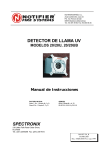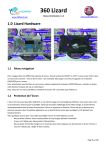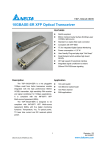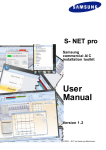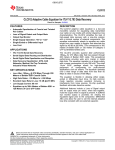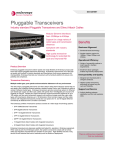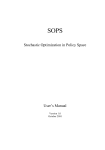Download Eye-BERT 10G Users Manual
Transcript
Eye-BERT 10G Users Manual Overview: The Eye-BERT 10G is a low cost, easy to use, all-in-one fiber optic test solution offering high performance bit error rate testing at a fraction of the cost while providing a rich set of features not found in other bit error rate testers. The Eye-BERT 10G can be controlled via front panel or through the use of a Windows application via the USB port. The Window application gives the user access to enhanced features such as variable bit rate, custom programmable patterns, transceiver diagnostics, and wavelength tuning (tunable option). Warnings and Precautions: Do not exceed 0dBm optical input power on any optical port Use only compatible fiber optical connections (FC/UPC unless otherwise noted) Use only the supplied 5VDC power supply Connections: The Eye-BERT 10G requires a 5VDC supply and proper fiber connections for operation. All fiber connections are FC/UPC either single mode or multimode depending on the unit options. An optional USB port is also provided for control and monitoring via a computer. The internal XFP transceiver is user replaceable by removing the two rear-panel screws and rear panel, and carefully sliding the lid out of the extrusion from the rear. Observing ESD precautions carefully remove the LC fiber connections and replace the XFP with any MSA compliant XFP transceiver making sure it is completely seated. See SFF INF-8077i for more details. Note: transceivers requiring more than 3.5W or a -5V supply are not supported. Upon power up the unit will recognize the new transceiver reporting its wavelength and power levels. www.spectronixinc.com Page 1 Eye-BERT 10G User’s Guide V 1.0 Stand Alone Operation: In stand alone operation all functions and controls are available to the user via the front panel key pad and LCD with the exception of programming custom rates and patterns. The following sections describe the operation of the front panel controls. Powering the Unit On/Off To turn the unit on or off, simply press and hold the “Power/Select” button for more than two seconds. Changing Operating Mode Press the “MODE” soft key and use the up / down buttons to highlight the desired mode, when the “MEAS” soft key is pressed the change will take effect. Changing the Configuration / Settings Press the “CONF” soft key and use the “Power/Select” key to highlight the desired parameter; change the setting by using the up / down buttons. When the “MEAS” soft key is pressed the change will take effect. The programmed 64 bit custom pattern will also be displayed BERT Mode The BERT measurement screen is shown to the left and displays all the associated measurement parameters. The actual bit error rate is displayed in the upper left corner with the optical input power and transmit wavelength below. The pattern and bit rate settings are displayed in the upper right corner with the actual error count and test time just below. The laser can be turned on or off by pressing the “power/select” button and is indicated in place of the wavelength read out. The “Optical” LED reflects the state of the optical input, a red indication is displayed when there is no optical input signal and a flashing green LED indicates that an optical signal has been detected but the pattern detector is not synchronized. A solid green LED is displayed when the pattern detector is locked and BER is being measured. The “Error” LED shows the error history: green indicates that no errors have been detected and conversely, red indicates errors have been received. The error counters can be reset by pressing the “CLR” soft key. Repeater / Retimer Mode In Repeater / Retimer mode the Eye-BERT 10G will lock onto any valid data rate and produce a retimed copy at the optical output. If the unit is able to lock to the incoming signal the optical LED will www.spectronixinc.com Page 2 Eye-BERT 10G User’s Guide V 1.0 illuminate solid green, if the unit is not able to lock but sufficient signal amplitude is received the LED will flash green. Memory Clearing / Factory Settings The Eye-BERT 10G stores configuration settings in non volatile memory; in some cases it may be desirable to restore the factory default settings. To do this, while the unit is powered off, press and hold the “Power/Select” button and “Up” arrow key simultaneously until the memory clearing screen is displayed, then follow the directions on the screen. This will reconfigure the unit to its factory default settings. Computer / GUI Operation In order for Windows to recognize the Eye-BERT 10G the USB driver must first be installed; after which the Eye-BERT 10G appears as an additional COM port on the computer. Currently Windows XP, Vista, and 7 are supported. 1. Copy the file “cdc_NTXPV764.inf” from the supplied CD to the hard drive. 2. Connect power to the Eye-BERT 10G using the supplied 5VDC adapter 3. Plug the Eye-BERT 10G into a free USB port. When the hardware installation wizard asks for the driver location, browse to the “cdc_NTXPV764.inf” location on the hard drive and complete the installation. Note, on some operating systems such as Window 7, manual USB driver installation may be necessary. If the hardware installation wizard fails, go to “My Computer” > “Properties” > “Hardware” > “Device Manager”, and find the “Spectronix” or “SERIAL DEMO” entry under “Other Devices” and select “Update Driver”. At this point you will be able to browse to the location of the driver. Optional The Eye-BERT 10G emulates a serial port via USB. When the device is plugged into a USB port, Window automatically assigns it a COM port number. This COM port is then used to communicate with the device. In order to determine what COM port Windows has assigned to the Eye-BERT 10G, right click on “my computer” and select “properties”. In the properties window select the “hardware” tab. Click on “device manager” and expand the “Ports (COM & LPT)” item. Locate the “Spectronix, Inc.” entry and note the assigned COM number, (ie “COM3”). Install the Eye-BERT 10G Application The Eye-BERT 10G application requires Microsoft .NET Framework 4. This application will automatically be downloaded and installed over the internet if required during the installation process. If the installation fails due to this error, follow the link below to manually install the required software: http://www.microsoft.com/downloads/en/details.aspx?familyid=9CFB2D51-5FF4-4491-B0E5-B386F32C0992&displaylang=en%3E Using the Supplied Eye-BERT 10G Application The Eye-BERT 10G Application is used for both the Eye-BERT 10G and the Eye-BERT Micro 10G and is able to determine which port Windows has assigned to the Eye-BERT and then automatically begin communicating with it. The Eye-BERT must be powered on and connected to a USB port prior to launching the Eye-BERT 10G Application. After starting the application, press the “Connection” button to automatically connect to the Eye-BERT, upon successful connection this button will turn green and the fields will begin to update. The user may also choose to select a specific COM port number from the drop down list; this is useful when there is more than one Eye-BERT connected to a computer. After communication is established the “Connection” indicator will turn green, the screen www.spectronixinc.com Page 3 Eye-BERT 10G User’s Guide V 1.0 will be populated with the current measurements, and the XFP model and serial numbers will be displayed in the application header. The Eye-BERT 10G has three modes of operation: Bit Error Rate Test mode, Repeater mode, and Frequency Generator mode. In repeater mode the input signal is simply looped through the XFP and retransmitted. In bit error rate test mode the Eye-BERT generates the specified pattern / bit rate while the detector attempts to synchronize to the pattern and count the bit errors. In frequency generator mode a 50/50% square wave is generated at the specified frequency. The frequency generator makes use of the programmable pattern generator to create 6 different frequencies at ratios of /64, /32, /16, /8, /4, /2. In this mode the pattern detector can be used to test at an effectively lower bit rate but the detector will over sample the received signal at the full rate. If a tunable XFP transceiver is used, the Eye-BERT 10G has the unique feature of being able to change the transmitted wavelength. Selecting the Wavelength indicator from the main screen will display the “Set Transmitter Wavelength” dialog box shown to the left. The dialog box gives the user the option of specifying a new wavelength in units of either THz or nm. When entering a value in the THz box the “New Wavelength” value will be updated with the corresponding wavelength in nm. Pressing “OK” will set the new wavelength. The table below describes the status indicators: Indicator Description Connection Green indicates that the application is communicating with the EyeBERT 10G on the indicated COM port. Signal Sync Green: No loss of signal is reported by the XFP Red: A loss of signal condition is reported by the XFP Green: The BERT pattern detector is synchronized with the selected pattern Red: The correct pattern was not detected Error History www.spectronixinc.com Green: No errors were detected during the last reading Red: At least one error was detected during the last reading Green: No errors since the last reset Red: At least one error has been detected since the last reset Page 4 Eye-BERT 10G User’s Guide V 1.0 Indicator Description Frequency Error Indicates that the device cannot generate the specified bit rate / frequency. When this error is active the measurements should be discarded as they may not be accurate. The table below describes the measurement fields: Measurement Description BER Bit Error Rate = number of bits errors / total bit count Errors Total number of bit errors since the last reset Count Total number of bits tested since the last reset Time Actual test time since the last rest = bit count / bit rate Receive Power Received optical power (dBm) as reported by the transceiver. Transmit Power Transmitted optical power (dBm) as reported by the transceiver. Wavelength Transmitted wavelength (nm) as reported by the transceiver Temperature Internal XFP temperature (°C) as reported by the transceiver. The table below describes the controls: Description Connect to The Eye-BERT Micro Procedure • Press the “Connection” button to automatically search for the device and begin communications. • Alternatively, select the proper COM port using the drop down list; this is useful when more than one unit is connected to the same computer. Select a bit rate • Select one of the preprogrammed standard bit rates from the tool strip buttons. Choose a custom rate • Enter the desired bit rate in the “Custom” bit rate text box and press the “Custom” button. The bit rate is specified in Gbps with 10 bps resolution. Select a Pattern • Select one of the preprogrammed standard patterns or Repeater Mode from the tool strip buttons. Choose a custom pattern • Enter any 64 bit pattern in the “Custom” pattern text box and press the “Custom” button. The pattern is specified as a 160 character Hex string. Generate a signal using Frequency Generator Mode Enable / Disable the transmitter www.spectronixinc.com • Select a standard or custom bit rate. • The frequency generator tools strip values will update with six different frequencies; select the desired frequency. • Select the Tx Power indicator to toggle the transmitter output Page 5 Eye-BERT 10G User’s Guide V 1.0 Description Procedure Change the laser wavelength • Select the Tx Wavelength indicator to display the “Set Transmitter Wavelength” dialog box. Entering a value in the dialog box will have no effect if the XFP transceiver is not tunable. Reset the error history and bit error rate • Press the “History” button Get information about the XFP transceiver • Press the “Read XFP” button to decode and display the “XFP Information and Diagnostic Registers” pop-up window, shown below. Test an XFP Module • Press the “Test XFP” button to perform automated testing on an XFP transceiver. The test first reads the XFP registers then performs bit error rate testing on the device based on the values read. A detailed test report is displayed within 20 seconds. Note: testing requires a loopback cable and attenuator be attached between the input and output of the module. Failure to properly attenuate the loopback may result in poor performance or damage to the transceiver. • Alternatively press the bit error rate display “Read XFP” Registers and “Test XFP” Results Calibration The Eye-BERT 10G utilizes optical power and temperature measurements as reported by the XFP module therefore the accuracy and calibration of these measurements is entirely dependent upon the XFP module. The Eye-BERT 10G pattern generation, detection, and timing parameters are all based on digital circuitry within the module and therefore require no calibration. www.spectronixinc.com Page 6 Eye-BERT 10G User’s Guide V 1.0 Letter of Volatility The Eye-BERT 10G contains both volatile and non volatile memory. The Eye-BERT 10G firmware application and configuration settings are stored in non volatile memory and program variables and settings are stored in volatile RAM which is cleared upon power down. The user has no means of altering the program memory without opening up the unit and reprogramming the device using a special programming adapter. The unit can be forced to its factory default state by following the “Memory Clearing / Factory Settings” instructions above. www.spectronixinc.com Page 7 Eye-BERT 10G User’s Guide V 1.0







